Françoise Athénaïs de Rochechouart de Mortemart, Marquise de Montespan
Françoise de Rochechouart de Mortemart was born on October 5 in 1640 into the ancient house of House of Rochechouart. Dating back to the days of Charles the Bald, who ruled as King of the Franks from 840 to 877, the House of Rochechouart teamed up with the House of Montemart, a Montemart is first mentioned in 1094, by marriage in 1205. Making them one of the oldest noble families in France.
Françoise, who would later call herself Athénaïs, did inherit all the illustrious qualities the de Rochechouart de Mortemart’s were famous for. Her father Gabriel de Rochechouart de Mortemart grew up in company of Louis XIII until the latter’s father, Henri IV, was assassinated in 1610. As childhood friend, he accompanied Louis XIII on several expeditions and received the position of premier gentilhomme de la chambre du roi -first gentleman of the royal bedchamber- in 1630.
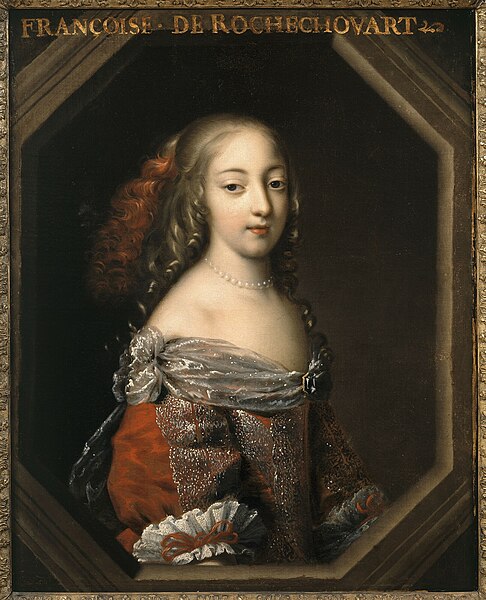
Gabriel was not just on very friendly terms with Louis XIII, Cardinal Richelieu and the young Anne d’Autriche held him in very high esteem, although Gabriel’s brother Louis and his cousin François were involved in the famous journée des Dupes and banished for it. Two years after his appointment of premier gentilhomme de la chambre du roi, he married Diane de Grandseigne. She was decribed as pious, without being a bore, of a sweet character, a dazzling beauty and confidant of Anne d’Autriche, acting as a dame d’honneur to her.
Five children were born to them between 1633 and 1645, Louis-Victor, Gabrielle, Françoise, Marie-Christine and Marie-Madeleine. Françoise was born at the château de Lussac and spent much of her childhood there. Diane de Grandseigne made sure her children were brought up with much maternal love and in a pious spirit, yet Françoise’s parents were not too often around, both having important positions at court. Thus she spent much time in company of her nurse Auzanneau, nicknamed Nono. Françoise did the occasional travel to court in Nono’s company, during which she, without doubt, caught a glance or two of the young and already very regal Louis XIV.
As Françoise was around eleven or twelve years old, she was given into the care of the Dames de Saintes and joined her sister Gabrielle there. In the convent both girls learned what was deemed essential knowledge for a girl of a good house; how to run a large household, needlework, dancing, writing, reading, some geography and history. Françoise also seems to have learned how to cook during this time. She was a smart girl with a great talent for words, the famous esprit de Mortemart. From her mother’s side, Françoise inherited her beauty and lush blonde hair. Her father gave her the esprit de Mortemart. The Mortemart’s were famous for their great wit and witty manner of speech, it ran in their blood. Gabrielle and Françoise perfected this gift. It is not easy the describe the essence of the esprit de Mortemart, for it was a mix of many things. A general smartness of the mind, the ability to access a situation quickly and to put it into words that sound pleasant although they might insult, to get away with the insult. Their words were sharp and amusing untruths preferred over truths, their conversation was daring and provoking, yet so charmingly delivered and phrased that it was almost an art. Gabrielle often teased Louis XIV that her family was so much older than the Bourbons and got away with it due to the way she phrased it a la esprit de Mortemart.
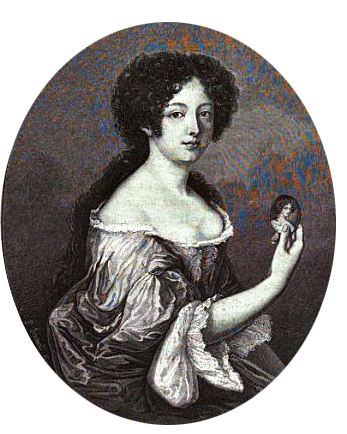
Françoise left the convent as she was already twenty years and joined the court as fille d’honneur in service of Madame. Then known as Mademoiselle de Tonnay-Charente, Françoise made quite the impression at court. She was stunningly beautiful, her figure just perfect, her neck and wrists worthy of poetry, her complexion much admired and her long blonde hair almost too much. She fitted the 17th century idea of beauty perfectly. On top of that her charm, wit, grace and elegance. Just like her mother, Mademoiselle de Tonnay-Charente was also quite pious and prudent thanks to her convent education. Françoise wrote poetry and amused/amazed with her words everyone around her, but finding a suitable husband for her proved a little difficult.
Although her family was so very illustrious, the lifestyle of her father caused a little trouble… and might have given her ideas. Gabriel de Rochechouart de Mortemart was a man of good tastes and this extended also to women. The Marquis de Mortemart had mistresses, one of them being Marie Boyer. A married woman well past her prime, but the Marquis fell head over heels for her and lived with her, quite openly, for the next twenty years. Marie Boyer was the hostess of a successful salon and although she wasn’t a young thing anymore, had many admires to due her lovely nature. The Marquise de Mortemart wasn’t too amused by her husband’s infidelity and acquired a separation from bed and table, a sort of 17th century divorce. Françoise witnessed it all and was probably on the side of her pious mother, but she also might have learned that a woman can have success on her own, never minding adultery, if she is smart and charming enough like Marie Boyer. The whole mistress and wife situation did cost her father a bit of money, which in turn meant that Françoise’s dowry was smaller than it should be for someone of her status.

Mademoiselle de Tonnay-Charente frequented the salons of Paris regularly in her first years at court. Especially that of the Hôtel d’Albret, belonging to the uncle of a former love interest of Louis XIV. It was during her time at the salons, lulled by talk of true love and romances, that Françoise became Athénaïs, a name she gave herself as homage to the Goddess Athene. (I shall call her that from now on. Athénaïs, not Athene.)
The first serious marriage prospect arrived as Athénaïs was already twenty-two, and almost an old maid in a time where most girls got married in their late teens. It was Louis Alexandre de La Trémoille, the charming and handsome Marquis de Noirmoutier, and he was quite in love with Athénaïs. Talk had it that Athénaïs was quite in love with him too and gave her approval to be betrothed ungrudgingly. But alas, it should not be… One evening, on the 20th January of 1663, the Marquis de Noirmoutier strolled through the Tuileries in company of friends, after having visited a ball hosted by Monsieur in the Palais-Royal, as his brother-in-law the Prince de Chalais got into a disagreement with the Marquis de La Frette. Harsh words are exchanged along with harsher blows. In order not to stir all of Paris, the gentlemen agreed to meet the next day for a proper duel. Pré-aux-Clercs, a meadow on the banks of the Seine, was the appointed spot and dawn the appointed time. It is not the first duel Pré-aux-Clercs will see, the place is famous for it and drank the blood of many young men. The Marquis de Noirmoutier is only injured, but the Marquis d’Antin, a member of Noirmoutier’s company is killed. The duellists flee quickly, but the matter is not over yet. Duels are officially forbidden since 1626 and death the penalty for offenders. As Louis XIV heard of the matter, he was positively furiously and intended to have everyone punished just like this. Before it could happen, the Marquis de Noirmoutier and the rest fled the country. Noirmoutier ended up in Spain and died there five years later fighting the Portuguese.
Athénaïs’ betrothal ended in a scandal, but when one door closes a other opens. The brother of the killed Marquis d’Antin, a certain Marquis de Montespan, Louis-Henri de Pardaillan de Gondrin, visited poor Athénaïs during the aftermath of the duel. Both are so deeply touched by what happened, it is said, that they connect with each other beyond feelings of mere friendship. Louis-Henri was quite enchanted by Athénaïs and she as well took a liking to him. Athénaïs was not the best match Louis-Henri could have and her dowry not too large, but he did not care so much for it. Talk had it that he preferred her good name and beauty to a large sum of money…. For Athénaïs he was not too good of a match either, but he came from a good house that had allied itself in marriage to that of Montespan, which was related to the King’s of Navarre after all and also claimed to have relations to the King’s of Spain.

There was only one problem…. while the father of the Marquis de Montespan is well-respected and an adviser to the state, the uncle is a bit of an issue. He is a prominent member of the Jansenism sect and therefore pretty much a heretic. (I won’t bore you with talk of Jansenism now. It’s basically a religious group based on the Catholic faith and contradicted the belief that eternal salvation could be achieved by actions on earth. The Jansenists disapproved of Louis XIV’s lifestyle and were pretty much non grata at court.) With a Jansenist uncle, it was impossible for the Marquis de Montespan to get a position at court, which in turn wasn’t too good for Athénaïs.
Historians have different opinions on why the marriage was still concluded. It might have been due to affection, the fact that Athénaïs’ father was unable to provide a larger dowry, the scandalous duel might have played a role, or simply that nothing better was available and Athénaïs realised that nothing better might be available any time soon. Her sister Gabrielle was already married for eight years and a proud Mama.
Whatever it was, Athénaïs married Louis-Henri de Pardaillan de Gondrin on January 28 in 1663, a week after the scandalous duel. Françoise later recounted that as she had neglected to bring along the proper kneeling cushions for the ceremony, the couple had to kneel on dog cushions. It is interesting to note that no member of the Royal Family signed the wedding contract. A couple like them could not marry without the King’s approval, yet there is no signature, not even that of Anne d’Autriche, being a friend to the bride’s mother, on the contract. They all seem to have refused to scribble their names on the same document as Montespan’s heretical uncle.
It seems their marriage was a little ill-omened from the start on, but at least the honeymoon was a success. Athénaïs got pregnant at once. Her dowry of 60000 livres was trusted into the hands of the grooms parents, and both sets of parents provided the newly weds with a yearly allowance. The couple moved into the a modest home in the Rue de Taranne and Athénaïs returned to court. On February 22 she danced as shepherdess in a ballet along with Louise de La Vallière, both knowing each other well from serving Madame. In the meanwhile, the Marquis de Montespan, who was notoriously fond of gambling, began to waste the couples allowance and amassed debts. He borrowed money where he could get it, against Athénaïs’ will, and dragged her into the whole thing. He ran up liabilities of 4200 livres in the first few months, when they had an allowance of 22500 livres for the whole year. Shortly after the Marquise had to rush her husband to two lawyers to prevent him from being arrested for his debts, this time he owed 2170 livres to merchants. They managed to settle the affair for a sum of 1000 livres and Athénaïs rushed back to court to prepare for her role in a ballet the following night. A other time her husband pawned Athénaïs’ pearl earrings for a bit of cash. The new Marquise de Montespan was in constant financial trouble, not what she had expected.
The situation did not improve much. Since the Marquis was forbidden to appear at court, the whole weight of courtly duties, and things such as winning friends and patrons, rested on the shoulders of Athénaïs…. but then a chance presented itself for her husband to gain a bit of Royal appreciation. The Duc de Lorraine had agreed in a treaty of the previous year to cede the town of Marsal to France, but was now refusing to do so, saying that the treaty was concluded by his nephew and not him. Louis XIV, eager to win some military glory, thus swore that if the Duc would not do as he should, Louis would pay him a visit accompanied by an army. Monsieur de Montespan volunteered at once. Eager to impress the King, Montespan borrowed as much money as he could to pay for his men and horses. He set off in hopes to improve his situation, but by the time Lorraine’s borders were reached, the Duc had given Marsal to France and Montespan returned with a debt of 13000 livres for nothing. His wife was furious, but there was not much she could do. She was in the last states of pregnancy and had to think of herself now. Their first child Marie Christine was born on November 17, pretty much nine months after their wedding.
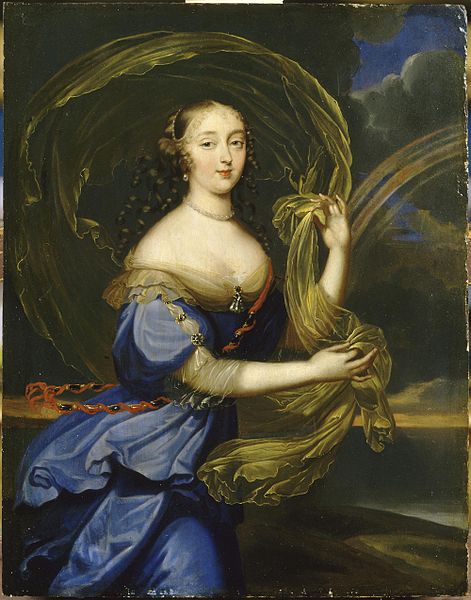
It became very clear now that their whole families fortune was in the hands of Athénaïs and it might have calmed her nerves a little as she was appointed the following year, with the help of Monsieur, to a position in the Queen’s household. This granted her an income again, after her old position as fille d’honneur to Madame had become forfeit with her marriage, but it also meant that Athénaïs life had to circle around court activities now…. and she needed the means for it. The Queen’s ladies, her French ones at least, where in the very centre of court attention and life at court was expensive. Madame de Montespan needed to look worthy of her new position, this meant gowns of the lastest fashion, she had to compete with the Comtesse de Soissons after all, a skilled maid to do her hair just perfectly, ribbons, jewels, a carriage worthy of a Marquise… she needed the money her husband was wasting on the card-tables. And if this wasn’t enough already, he had returned from another failed military expedition with more debts and no won glory. The birth of their second child and first son, Louis Antoine, on September 5 in 1664 also meant a enlargement of their own household was necessary.
Up to this point, Madame de Montespan was still a modest, although vain about her looks, and pious person. She did her very best to appear as if she was in no financial trouble and charmed everyone around her. Two years later, she sneaked her way into the King’s bed.
Athénaïs had witnessed the rise of Mademoiselle de La Vallière from some being someone no-one cared about to maîtresse-en-titre. In 1666 she witnessed how Mademoiselle de La Vallière sat next to the Queen at mass and she certainly also noticed how Mademoiselle de La Vallière looked like she was embarrassed by it all. How she wasted her chances to improve her wealth, fortune, and standing. Athénaïs was also very aware that Louise was not the only one who shared the King’s bed, everyone knew it, and Athénaïs certainly knew that Louis XIV amused himself with her own sister. Madame de Montespan might have thought, aided by her Mortemart blood that made all members of the family think they are very far above the rest, that she would do a better job than Louise. She was prettier, more charming, more graceful, smarter, wittier… and certainly not as silly as wallflower Louise.
Whatever it was that motivated her, the Sun King wrote during this time “She does what she can, but I do not want her.”
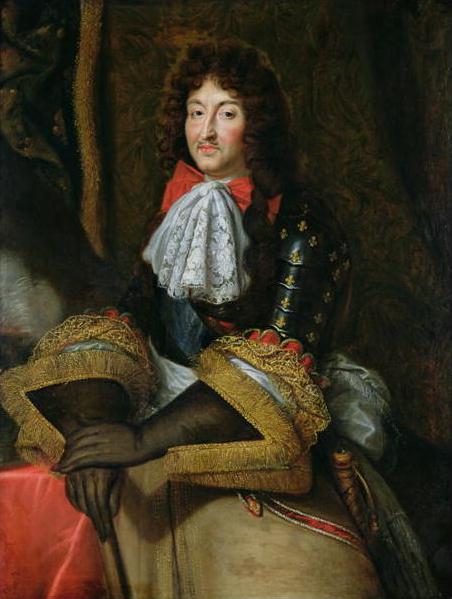
Madame de Montespan’s motivation is a little unclear. She was certainly no Louise and did not stumble into the King’s bed. Athénaïs tried to get his attention, at the same time seems to have been unsure what it could mean for her and even tried to persuade her husband to take her away from court from a while. He did not and although Athénaïs was still more drawn to virtue than vice, she did not cease her attempts to win the affection of the Sun King. The fact that she did it very smartly and subtly, might hint that although one part of her struggled, the other was determined to become the new mistress of the King.
The Marquise already had the Queen on her side. The latter loathed Mademoiselle de La Vallière and adored Athénaïs for her charm and wit, something that would change soon. Athénaïs also counted Mademoiselle de La Vallière among her friends and Louise suspected nothing. It was clear for everyone at court that Louise did not charm her Louis as much as she used to anymore. The Sun King had grown a little bored of her. Louise knew it and talked to Athénaïs of it. Athénaïs was in the perfect position to push her luck by some more flirtatious advances in hopes it might bring her closer to the King’s attention, but she did not need to. Mademoiselle de La Vallière turned to her good friend in hopes the Marquise might help her to keep the King’s affection. No-one else was willed to help poor Louise, but Athénaïs agreed happily. From now on, Louise was always in company of Athénaïs when he Louis visited and for a moment it appeared like her plan worked. Louis was much more merry during their suppers. He laughed at Athénaïs’ jest and jested in turn.
Louis XIV changed his ‘I do not want her’ to a ‘I might want her’ during this time and the court noticed it as well. The Duc d’Enghien noted: “that he (the King) sighs a little after Madame de Montespan, and, to tell the truth, she well deserves it, because one could not have more spirit nor more beauty than she has, but I, however, have remarked nothing going on there.”

That changed a few weeks later. Athénaïs had successfully made herself interesting enough, with little glances and dreamy looks, a flirty smile here and there, but never going too far and withdrawing to stir more need, playing the coquette and at the same time remaining somewhat virtuous. She gave enough to wake serious desire, but not enough to satisfy, until Louis could think of nothing else than her. That glorious Goddess.
In the first few months of 1667, Louis took steps to make said Goddess his new mistress. Mademoiselle de La Vallière, as a sort of farewell present, was made a Duchesse in her own right, her children by the King legitimised and he promised to do the same with the one she was carrying this very moment. Louise remained behind as the court set off in direction of Flanders, it was the time of the War of Devolution. Louis had ordered her to stay in Paris to prepare herself for the birth of the child, but in a rare attempt of bravery, Louise acted against the King’s orders and followed. The whole thing ended in a carriage race between the carriages of Louise and the Queen. Louise won and Athénaïs, being in the Queen’s carriage, remarked loudly she would never want to be the King’s mistress and would not dare to show herself in presence of the Queen if it were so….
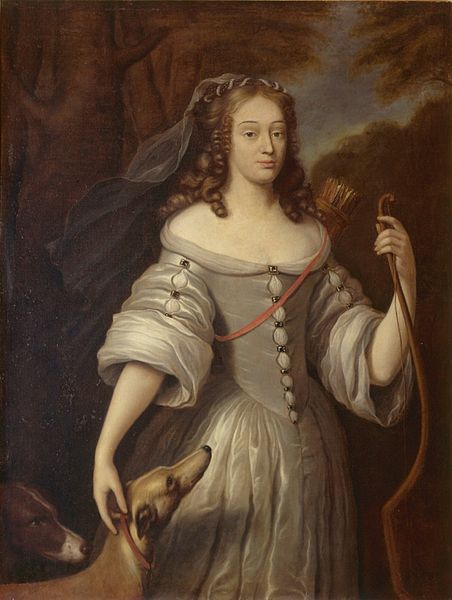
Louise had sealed her own fate. Her Louis still treated her with respect, but people did not doubt it was more due to her new position as Duchesse than anything else. Louise was falling and Athénaïs’ star rising.
It was in Flanders that the great Sun King finally attempted to conquer his beautiful Goddess. The Marquise lodged in the household of Julie d’Angennes, Duchesse de Montausier and première dame d’honneur to Marie-Thérèse, at Avesnes as she received a surprise visit. The story goes that Athénaïs just had a bath as a man entered, wearing the uniform of the servants of the Duc de Montausier. Said man was so transfixed by what he saw that he was unable to move and a bit dumbstruck, he just stood there and looked at her until Athénaïs started to laugh and let her towel drop…. On other occasions the mysterious man returned disguised as a guard. It was also observed that the beautiful Marquise suddenly neglected her duties and the King, for some reason, spent much time in his private rooms. The Queen, usually the last to know anything, observed an alteration in her husband’s habits, without having any clue what might be the reason, and asked one evening what kept him from bed until four o’clock in the morning. Louis dryly replied dispatches were the cause… and turned to his cousin La Grande Mademoiselle to hide his silly grin from the Queen. Louis forced the latter to follow him everywhere now, so he might continue to enjoy the alluring charms of Athénaïs, and joked with Madame de Montespan during the long carriage rides. They pretended the carriage had crashed every time La Grande Mademoiselle dared to doze off. When Louis was not in one carriage with the three of them, he rode next to it. Merrily singing. It was a hot summer and Madame de Montespan took to complain of a mysterious faintness, so she may stay in her rooms during the long afternoons…
Louis XIV was in a merrier mood than ever and his conquests a great success, both that of Flanders and Athénaïs. As the court returned to spent the winter in Paris, and later Versailles, Marie-Thérèse was still convinced it was Louise she must hate, but observant eyes had long noticed it was Athénaïs who put the King in such a good mood. Athénaïs loved sex as much as Louis and the King’s appetite was great in that department. It is said he went to her three times a day and sometimes was so impatient that he started to undress her already even-though her maids were still in the room. Luckily for Madame de Montespan, the Queen was not suspicious at all. Not even as a letter was sneakily handed to her, which told of the adventures her husband had with Madame de Montespan and how the Duchesse de Montausier was covering for them. Marie-Thérèse believed someone tried to fool her, saying that two ladies as loyal as the accused ones would never betray her so.
And so started the age of the Three Queens Of France, as they were called by passersby witnessing Marie-Thérèse, Louise and Athénaïs in one carriage.

From now on it was the job of Louise de La Vallière, still the official mistress, to cover for the new one. Bedsports with an unmarried Mademoiselle was one thing, for the church it counted as simple ‘fornication’, while Louis’ activities with Madame de Montespan were double adultery, ‘unlawful intercourse between persons who are both married to other persons’. And this was not the only problem. Should Louis get Athénaïs, who will prove to be very fertile, pregnant the resulting child would automatically by law be that of her husband. Something that had to be avoided at all cost.
The Marquise de Montespan became the Queen of the court, while poor Louise still covered for her. Athénaïs understood it very well to keep her Royal Lover in good spirits. Not only with their equal desire for bedsports, also with her love for good food, something Louis appreciated greatly in ladies. Versailles was another passion they shared. Athénaïs was able to fully grasp the concept Louis XIV had in mind, she understood it was more than a mere building, more than a palace. She even designed a fountain for Versailles’ gardens, a giant golden weeping willow with over one-hundredth water jets.
Versailles, Athénaïs, Louis. It was a perfect match. In 1668, Athénaïs was the secret Queen of a fête, like Louise de La Vallière had been during the Plaisirs de l’Île enchantée in 1664. In the chateau she had twenty rooms at her disposal, while Marie-Thérèse had only eleven, and the Trianon de Porcelaine, built in 1670, was her own little Kingdom to entertain the King in private.
The court loved and feared the Marquise. She did everything in her power to amuse the Sun King, often at the expense of others and her smart tongue was feared as much as it was admired. Athénaïs quickly understood that one way to please her lover, was to make fun of others and she spared no-one as long as it would make Louis laugh. Her rooms in Versailles faced a court-yard and Madame de Montspan had the habit of making fun of those she saw from her windows. Passing them soon became known as ‘going before the guns’.
What about Monsieur de Montespan? Up to the end of 1668, he had no clue what was going on. The time he spent in Paris was only brief, for fear creditors might get to him, and he amassed another 48000 livres in debt. He did not find it suspicious that his wife had relocated their household closer to the Louvre either.
The next year, Madame de Montespan discovered to her great shock that she was pregnant. She was so anxious about it, writes Madame de Caylus, that she lost much weight and her complexion faded. Athénaïs did her very best to hide her pregnancy as good as possible and invented a new fashion for the occasion. A loose gown of flowing fabric based on a robe battante, which was nicknamed l’Innocente. It worked for the first pregnancy, but as time passed the court was very aware that whenever Athénaïs got her l’Innocente out, she must be pregnant.
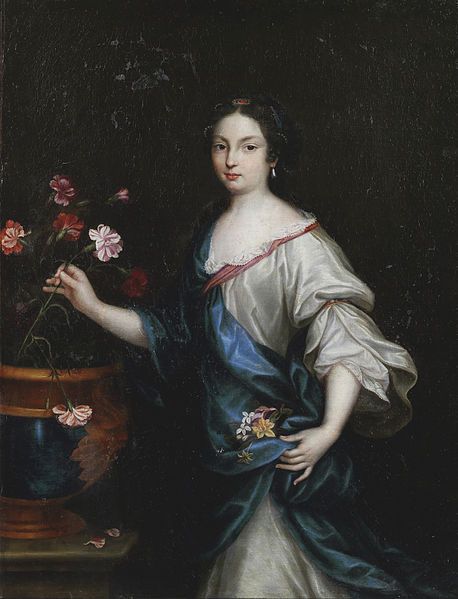
As the time came for birth of said child, the Sun King showed himself in very human form. Louis arranged for a house to be rented in the rue de l’Echelle, close to the Tuileries, and a masked Athénaïs was brought there. The story goes that a man named Clément, a male midwife, was brought there blindfolded and, as the blindfold was removed, found himself in a room with a mysterious masked woman placed in a bed. All candles were put out and Clément uttered his surprise at the odd arrangements, saying they must be there to hide a great scandal. A man, hiding behind bed curtains, silenced him thus, but the good Clément said he could not possible get to his work until he had a snack. The man, young and rather handsome (Guess who…) appeared and handed him some bread and marmalade. Clément devoured it and added he could do with some wine too. “Have patience, I can not do everything at once.” the young and rather handsome man said before handing him wine, then vanished behind the curtains again. He held the hand of the mysterious woman as labour started and was impatient to get it all over. At last, a daughter was born and the young and rather handsome man handed it to a lady that looked suspiciously like Claude de Vin des Œillets, which took the child away. The daughter received the name Louise Françoise and died only aged three in 1672.
Although such great secrecy was displayed, Paris was soon full with talk of Madame de Montespan giving birth to a child fathered by the King. Now Monsieur de Montespan got the hint and was furious. He bored the polite society of Paris with talk of his horns, slandered both the King and the Marquise, he insulted her whenever he saw her. Stalked her, waited in her rooms for her, sneaked in when she slept, broke doors open. Athénaïs was truly terrified and moved into the apartment of her old friend the Duchesse de Montausier, but Montepan did not leave her in peace. Now he broke into the apartment of the Duchesse and tried to force himself upon Athénaïs as she clung weeping to her friend. Monsieur de Montespan beat his wife and ran through Paris bloating of his visits to the filthiest brothels he could find. His plan was apparently to infect himself with a nasty disease that he could give to his wife and his wife to the King.
Louis XIV was not amused, obviously. Even-though King, he could not do much in first. Athénaïs had to do with some bodyguards until a reason was found to banish her husband, beating and raping one’s wife did not count. The reason they came up with had to do with the Montausiers. As thank you for his and his wives secrecy, it appeared, the Duc de Montausier was made gouverneur of the Dauphin. Monsieur de Montespan thought so at least and openly disagreed with the decision. He was put in jail for a good week and afterwards ordered to remain in his country estate. He took his children with him and informed the servants of his estate that his wife had died. Then arranged for a funeral to take place in which a Athénaïs dummy was buried. As if this was not enough, he also had his carriage decorated in mourning and two large antlers installed on it.
Louise de la Vallière’s reign as mistress came to an end 1674, as she was finally allowed to withdraw from court. Poor Louise had suffered much during the last years. She saw her former lover make merry with her former friend and her former friend treated her like a servant. At one point they shared and apartment, Louise having the front rooms and Athénaïs the adjoining ones, and Louise had to witness how the King sauntered through her rooms to reach those of la Montespan.
Athénaïs was now the official mistress and treated as such, but also confronted with its dangers. The church was not too fond of her and there were many young girls at court that sought to take her place. Her figure was not the best anymore either, all her pregnancies had taken toll and her love to eat had made her a little broader. It was now more important than anything else for her to keep the King’s affections, but this proved a little difficult. Louis had always more than one lover and while Athénaïs had no trouble to fight them off in the past, Louis was a little fed up with her scenes by now. Athénaïs was proud, vain and demanding. Sometimes too demanding for him.
Madame de Montespan figured out that if the King wanted to amuse himself elsewhere, he might as well do it with someone she choose, someone who would be of only little danger to her. Her maid, Claude de Vin des Œillets, for example. Or her charming niece, the wife of the Duc de Nevers.
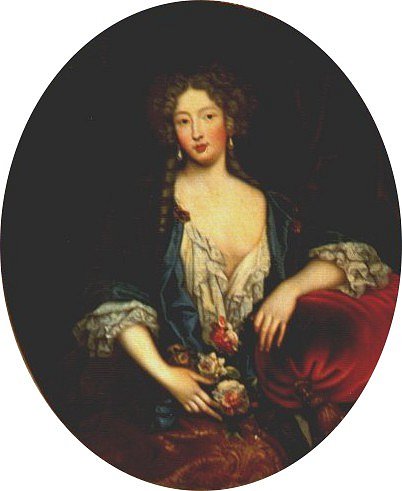
They were no danger for her, but Marie Angélique de Scorailles was. Said to be pretty but stupid like a basket, Marie Angélique de Scorailles caught the eye of the King and got pregnant. Madame de Montespan was furious. There was also Françoise d’Aubigné, widow of the poet Scarron. Athénaïs knew her well from her days in the Hôtel d’Antin and as a confidant and governess for her children from the King was needed, Madame de Scarron was the chosen one. She did her job very well and moved to court as Louis XIV legitimised said children. Madame de Scarron had a strong bond to them, which made her bond with Louis. The latter rewarded her generously for her services and even made her a Marquise. A Marquise just like Athénaïs was…. but Marie Angélique de Scorailles was the greater danger now.
Louis showed her great affection and this silly thing flaunted it. It might have been around this time that Athénaïs involved herself with what would be the reason of her downfall. Although most people did not believe in witchcraft anymore, there was the belief that if something was done in a certain fashion, it might help to achieve a certain outcome. It is uncertain to what degree Madame de Montespan believed in this and how far her personal involvement in the matter reached, but it appears Athénaïs sought the help of a sorceress to bind the King to her. Already in 1667, a woman nicknamed La Voisin was apparently hired by Claude de Vin des Œillets on behalf of Madame de Montespan to perform a black mass. It was the very year the King fell for Athénaïs and it is said she turned to La Voisin regularly from then on. For example in 1673, as she thought the King’s love was declining. A series of black masses were performed and Athénaïs served as altar during at least one of them. In 1679, Madame de Montespan employed La Voisin again, this time to aid her against Marie Angélique de Scorailles. Allegedly she even wanted both her and the King dead.
As Marie Angélique de Scorailles died in 1681 the words poison and Montespan were muttered in one sentence. Marie Angélique de Scorailles died in June after she gave birth prematurely in March and never recovered from it. This dragged Madame de Montespan into L’affaire des poisons.
La Voisin was arrested in 1679 and confessed that she performed black masses and sold aphrodisiacs to prominent members of the court. Gabriel Nicolas de La Reynie, Paris’ first Lieutenant General of Police and the chief judge of the court, before whom the famous poisoning cases were brought, heard a testimony that placed Madame de Montespan’s first visits to La Voisin in 1665. According to it, they repeatedly carried out rituals to create a special potion for the King. La Voisin and Madame de Montespan would call on the devil and pray to him for the King’s love. As a way to express her gratitude for her request, they sacrificed a newborn’s life by slitting its throat with a knife. Then the baby’s body would be crushed, the drained blood and mashed bones would be used in the mixture, which was then, without the King’s knowledge, put into his meals and wine.
Those accusations came from people, who were as good as dead. It could be that they just made it up in hopes to prolong their lives by mentioning great ladies, in which case their sentences might be put off until they had spilled the beans on everything they knew of those great ladies. However, the accusation of potions being put in the King’s drink and food is interesting, for Louis XIV suffered of strange headaches regularly during this time and they vanished as soon as he stopped to consume food in Madame de Montespan’s presence.
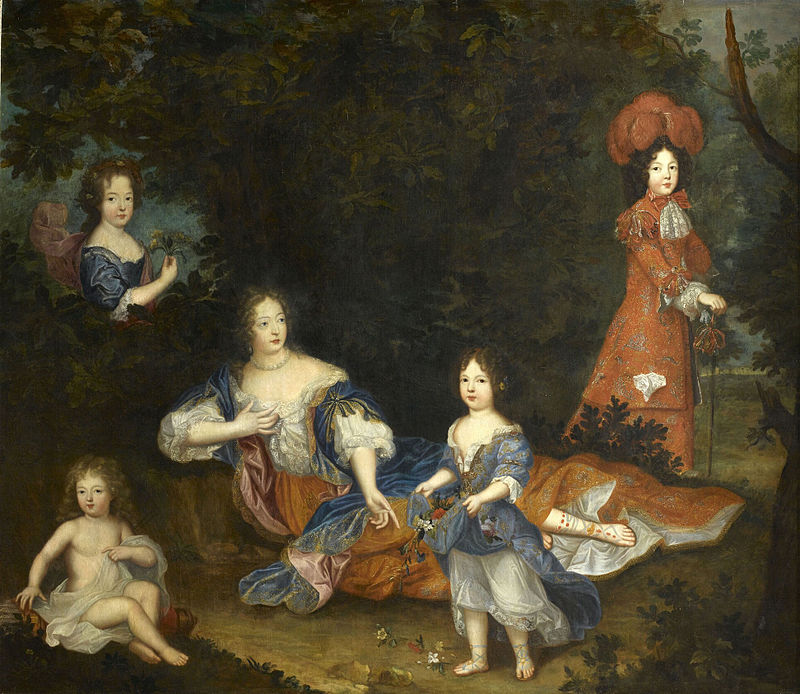
True or not, Athénaïs’ fate was sealed. Between 1669 and 1678, she had given birth to seven children fathered by the Sun King. Louise Françoise de Bourbon in 1669, Louis Auguste de Bourbon in 1670, Louis César de Bourbon in 1672, Louise Françoise de Bourbon in 1673, Louise Marie Anne de Bourbon in 1774, Françoise Marie de Bourbon in 1677 and Louis Alexandre de Bourbon in 1678. Now, after the full proportions of Athénaïs’ possible involvement reached the ears of the King, he found himself unable to love and trust her any longer. That she might have tinted his meals with disgusting potions made him go pale. That she might have bewitched him to make him fall in love enraged him.
It was decided to cover the whole affair up in order to avoid a scandal that would shake all of France. If the allegations were true, it would mean the King had been bewitched by those closest to him, but he could not simply break with Athénaïs just like that. It would have caused too much talk and suspicion, especially since talk circulated linking Madame de Montespan to the death of Marie Angélique de Scorailles. Louis XIV saw that this whole affair could harm him immensely if it surfaced… and so he did not break with Athénaïs openly and continued to visit her regularly, but her time as his lover was over. Madame de Montespan never recovered from the accusations and no matter how often she swore to have nothing to do with it, swore that it all were lies, Louis remained suspicious. Admittingly, it might have served his plans too. Athénaïs did not have the effect on him she once had. He had grown older, was no longer the vigorous energetic handsome young man. He had become more serious, the mistakes he did in the past weighted him down, he was worried about the future and, due to the influence of the Church and Madame de Maintenon, turned more towards religious matters. The days were he danced through the night with a sparkling Montespan by his side did not fit into his current state of mind anymore.
The Marquise remained in Versailles and was treated will all respect by Louis XIV, but that was it. She had lost her influence over him. In first Athénaïs’ role was not so much that of a disgraced mistress, but this changed in 1685. In January that year, she had to leave her luxurious apartment on the first floor for the former bathroom apartment on the ground floor. Two years later, in 1687, Louis, who had visited her until then in the mornings after mass and in the evenings after supper, shifted his visiting times to shortly before he retired.

The only thing that consoled her from her disgrace was watching her children being married off so well. Louis Auguste, the Duc de Maine, married a princesse du sang and grand-daughter of le Grand Condé. Louise Françoise married a prince du sang. Françoise Marie married the heir of Louis XIV’s brother. Louis Antoine, her son by Monsieur de Montespan, married a daughter of the Duc d’Uzès.
Madame de Montespan withdrew from court in 1691. She moved into the convent Saint-Joseph in the Rue Saint-Dominique in Paris. Louis XIV gave her a pension of 500000 francs for the occasion. There she abandoned her lovely robes, jewels, and extravagant hairdos, to live a more simple life with much prayer. Athénaïs does plenty of charity work and supports young and poor girls with her own money. She returned to court from time to time, to act the Grande Dame when her presence was necessary, but Versailles was no longer her home.
It was in 1707, during a spa at Bourbon-l’Archambault, that her health began to deteriorate and Athénaïs feared that Death was knocking on her door. Discomforts plagued her and made her entourage fear a attack of apoplexy might be on the way, since she had suffered of seizures seven years previously. Athénaïs dedicated her last days to God.
Madame de Montespan died at around 3 o’clock in the morning on the 27th May in 1707.
Her three youngest children felt the loss of their mother the most…. Louis XIV forbade them all to wear mourning for their mother. Being informed of her death, he said “Depuis que je l’avais congédiée, je comptais ne la revoir jamais.”
Madame de Montespan was buried, like all Rochechouarts, at the église de Cordeliers de Poitiers. The Revolution destroyed her resting place and her bones were scattered along with those of the rest of her family.
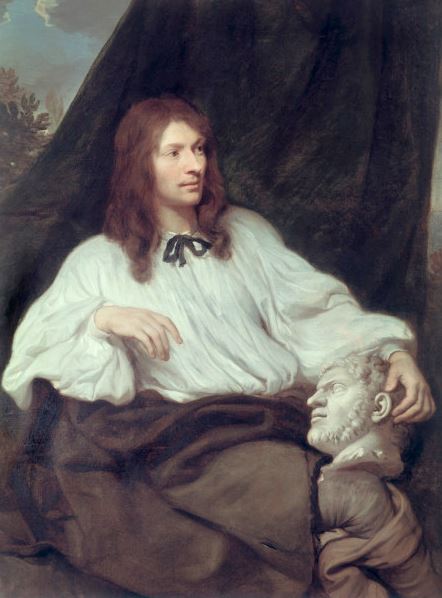

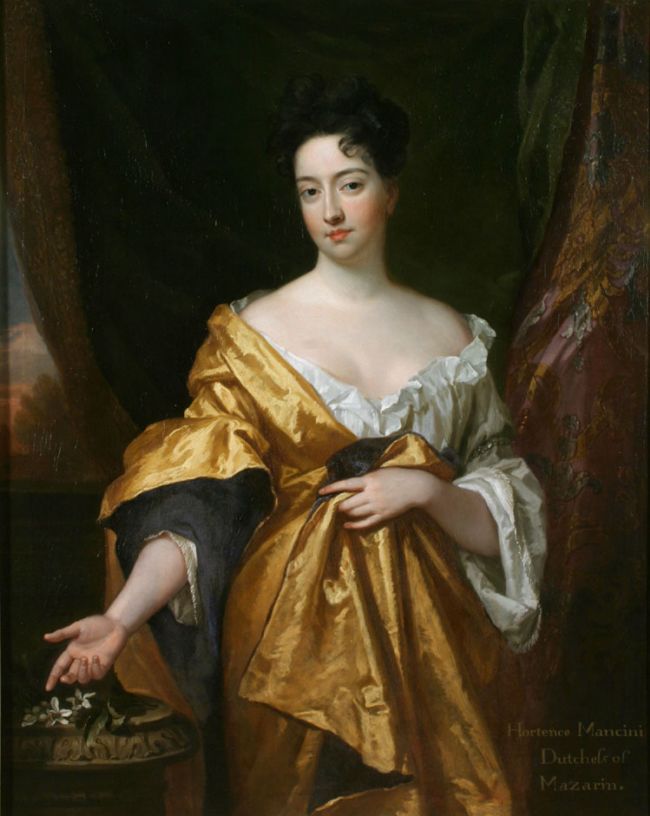

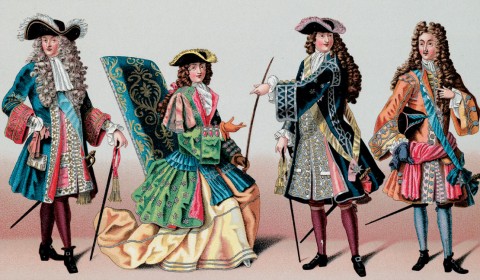
2 Comments
Bridget
Lovely and detailed article! I really enjoyed reading this and learning about la Montespan. thank you!
Patricia O
“A good read” as we English say informally. I remember either hearing or reading something to the effect that certain papers pertaining to the involvement of Madame de Montespan in the affair of the poisons were forbidden to be read by the general public . Or is that the 17th century equivalent of an urban legend? It’s so hard to discern what might have been true and what was court gossip.